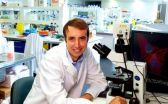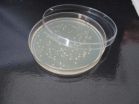(Press-News.org) A research team at the University of Guelph has developed a new line of transgenic "Enviropigs." The new line of pigs is called the Cassie line, and it is known for passing genes on more reliably. The results of this project were published ahead of print in the Journal of Animal Science.
Enviropigs have genetically modified salivary glands, which help them digest phosphorus in feedstuffs and reduce phosphorus pollution in the environment. After developing the initial line of Enviropigs, researchers found that the line had certain genes that could be unstable during reproduction or impractical in commercial use.
Scientists at the University of Guelph created the Cassie line to address these problems. In their paper for the Journal of Animal Science, they explain that the Cassie line has the same ability to digest high levels of phosphorus in plant matter.
Phosphorus is crucial for healthy growth in pigs. Unfortunately, 50 to 70 percent of the phosphorus in grain is in the form of phytic acid, a compound indigestible by pigs. Because of this, many farmers have to supplement pig diets with an enzyme called phytase. Phytase breaks down phytic acid and helps pigs digest more of the nutrient. The phytase enzyme has a hefty price tag for farmers, and the enzyme can be accidentally damaged or destroyed when farmers mix feed.
The Enviropig was created to solve this problem. The transgenic pig synthesizes phytase in its salivary glands, eliminating the need for additional supplements or enzymes in the feed. By digesting more phosphorus, the Enviropig also produces less phosphorus in its waste.
"The enzyme is secreted in the saliva and functions in a similar fashion to that of phytase included in the diet," said Dr. Cecil Forsberg, Professor Emeritus, Department of Molecular and Cell Biology at the University of Guelph and co-author of the study.
Though no studies indicate a food safety risk from genetically modified Enviropig pork, meat from the Enviropig is not yet available for human consumption. Forsberg said using Enviropigs could improve food production and the environment.
"When transgenic food animals are accepted by consumers, the Enviropig perhaps would be one of the first innovations to be introduced into swine production," said Forsberg. "We have demonstrated that the gene can be transferred by breeding through many generations in a stable fashion. Furthermore, the pigs are healthy."
Research on the Cassie line stopped in June 2012, but researchers collected semen from the pigs, and they have the option to breed new Enviropigs.
###
This paper is titled "Digestive utilization if phosphorous from plant based diets in the Cassie line of transgenic Yorkshire pigs that secrete phytase in the saliva." It can be read in full at journalofanimalscience.org.
Scientists improve transgenic 'Enviropigs'
Transgenic pigs could reduce livestock's impact on the environment
2013-03-07
ELSE PRESS RELEASES FROM THIS DATE:
Study finds risk of brain damage in college football players, even among those without concussions
2013-03-07
Wednesday, March 6, 2013, Cleveland: Concussions are the leading cause of brain damage in sports, particularly in football. However, researchers at Cleveland Clinic and the University of Rochester have found that football players may suffer long-term brain changes even in the absence of concussion.
In a study of 67 college football players, researchers found that the more hits to the head a player absorbed, the higher the levels of a particular brain protein that's known to leak into the bloodstream after a head injury. Even though none of the football players in the ...
Scientists at A*STAR's Genome Institute of Singapore catch evolving germs and cancer cells early
2013-03-07
Scientists at A*STAR's Genome Institute of Singapore (GIS) have developed a novel technique to precisely monitor and study the evolution of micro-organisms such as viruses and bacteria. This is an extremely important capability as it allows scientists to investigate if new drugs designed to kill them are working, and catch the development of resistance early on.
Micro-organisms and cancer cells evolve more quickly than normal human cells as their rapid life-cycles enable faster selection of advantageous mutations. Previously, scientists have had to wait for the selection ...
Fatty acids could lead to flu drug
2013-03-07
Flu viruses are a major cause of death and sickness around the world, and antiviral drugs currently do not protect the most seriously ill patients. A study published March 7th by Cell Press in the journal Cell reveals that a compound derived from fats found in fish oils prevents death in influenza-virus-infected mice, even at advanced stages of disease. The study offers a promising strategy for the treatment of patients with severe influenza virus infections.
"Given the potential for future lethal pandemics, effective drugs are needed for the treatment of severe influenza, ...
Sniff, sniff. What did you say?
2013-03-07
When animals like dogs or rats sniff one another, there might be more going on than you'd think. Research reported in Current Biology, a Cell Press publication, on March 7th finds in rats that those sniffing behaviors communicate information about an individual's social status. In those encounters, more dominant rats act as primary sniffers, while subordinate sniffees actually slow their breath.
"We know that rats and other animals can communicate through vocalizations, physical contact, odors, and also visual displays," says Daniel Wesson of Case Western Reserve University. ...
When food is scarce, a smaller brain will do
2013-03-07
A new study explains how young brains are protected when nutrition is poor. The findings, published on March 7th in Cell Reports, a Cell Press publication, reveal a coping strategy for producing a fully functional, if smaller, brain. The discovery, which was made in larval flies, shows the brain as an incredibly adaptable organ and may have implications for understanding the developing human brain as well, the researchers say.
The key is a carefully timed developmental system that ultimately ensures neural diversity at the expense of neural numbers.
"In essence, this ...
Using human brain cells to make mice smarter
2013-03-07
VIDEO:
What happens when human brain cells that surround and support neurons are implanted into the brains of newborn mice? Researchers reporting in the March 7th issue of the Cell Press...
Click here for more information.
What happens when human brain cells that surround and support neurons are implanted into the brains of newborn mice? Researchers reporting in the March 7th issue of the Cell Press journal Cell Stem Cell recently found that such mice had enhanced learning and ...
Persistence pays off in solving hemophilia mystery, showing curiosity drives discovery
2013-03-07
An Australian researcher has found the third and final missing piece in the genetic puzzle of an unusual form of hemophilia, more than 20 year after he discovered the first two pieces.
Professor Merlin Crossley, of the University of New South Wales, and his international team studied the blood-clotting disorder, hemophilia B Leyden, which is unusual because symptoms improve after puberty.
The results, published in The American Journal of Human Genetics, explain how more than half of the cases of this rare, hereditary bleeding disorder occur, and could help improve understanding ...
American Academy of Microbiology releases resistance report
2013-03-07
What do cancer cells, weeds, and pathogens have in common? They all evolve resistance to the treatments that are supposed to eliminate them. However, researchers developing the next generation of antibiotics, herbicides, and anti-cancer therapeutics rarely come together to explore the common evolutionary principles at work across their different biological systems. The new American Academy of Microbiology report "Moving Targets: Fighting Resistance in Infections, Pests, and Cancer" concludes that scientists working on different kinds of treatments have much to learn from ...
Dual systems key to keeping chromosomes intact
2013-03-07
USC scientists have discovered how two different structural apparatuses collaborate to protect repetitive DNA when it is at its most vulnerable – while it is being unzipped for replication.
The centromere—the center of the "X" shape of a chromosome—contains repeated DNA sequences that are epigenetically coded to attract so-called heterochromatin proteins. This protects the structure to ensure that the chromosomes separate properly. If the heterochromatin is lost (due to mutations in the cell), the repetitive DNA becomes vulnerable to rearrangements and recombination. ...
New hypothesis: Why bacteria are becoming increasingly more resistant to antibiotics
2013-03-07
According to his theory, bacteria that are non-resistant to antibiotics acquire said resistance accidentally because they take up the DNA of others that are resistant, due to the stress to which they are subjected.
A University of Granada researcher has formulated a new hypothesis concerning an enigma that the scientific community has still not been able to solve and which could revolutionise the pharmaceutical industry: Why are bacteria becoming increasingly more resistant to antibiotics? His work has revealed that the use of antibiotics can even cause non-resistant bacteria ...
LAST 30 PRESS RELEASES:
The perfect plastic? Plant-based, fully saltwater degradable, zero microplastics
Bias in data may be blocking AI’s potential to combat antibiotic resistance
Article-level metrics would provide more recognition to most researchers than journal-level metrics
Satiety’s little helper: Protein that supports appetite regulating protein identified
UF dives deep into predicting storm damage with computer models
A stormy ocean voyage yields insights on the global carbon cycle
Scientists identify first non-coding gene that controls cell size
Demonstration of altermagnetism in RuO₂ thin films -- A new magnetic material for the AI era
Penn researchers awarded $25M to conduct trial using smartphones to fight heart disease
PCORI awards funding for new patient-centered healthcare research
Exploring the origins of the universe: 145 low-noise amplifiers complete ALMA telescopes
Empress cicada wings help illuminate molecular structure
Using sound waves to detect helium
Time burden in patients with metastatic breast and ovarian cancer from clinic and home demands
Researchers discover bias in AI models that analyze pathology samples
Scientists ID potential way to prevent brain injuries from triggering Alzheimer's
MASTER 2nd Open Call: Execution period kick-off
Algae for health in food and pharma
Advanced microrobots driven by acoustic and magnetic fields for biomedical applications
Chicago health information leader recognized for raising CPR readiness and blood pressure awareness
The Intimate Animal, a new book from Kinsey Institute Executive Director Dr. Justin Garcia
When blue-collar workers lose union protection, they try self-employment
New video dataset to advance AI for health care
MEA-based graph deviation network for early autism syndrome signatures in human forebrain organoids
New modeling approach sheds light on rare gut disease
Study documents potentially hazardous flame retardants in firefighter gear
Can certain bacteria regulate aging of the immune system and its related alterations?
AI model helps diagnose often undetected heart disease from simple EKG
There are fewer online trolls than people think
Cell membrane fluctuations produce electricity
[Press-News.org] Scientists improve transgenic 'Enviropigs'Transgenic pigs could reduce livestock's impact on the environment


